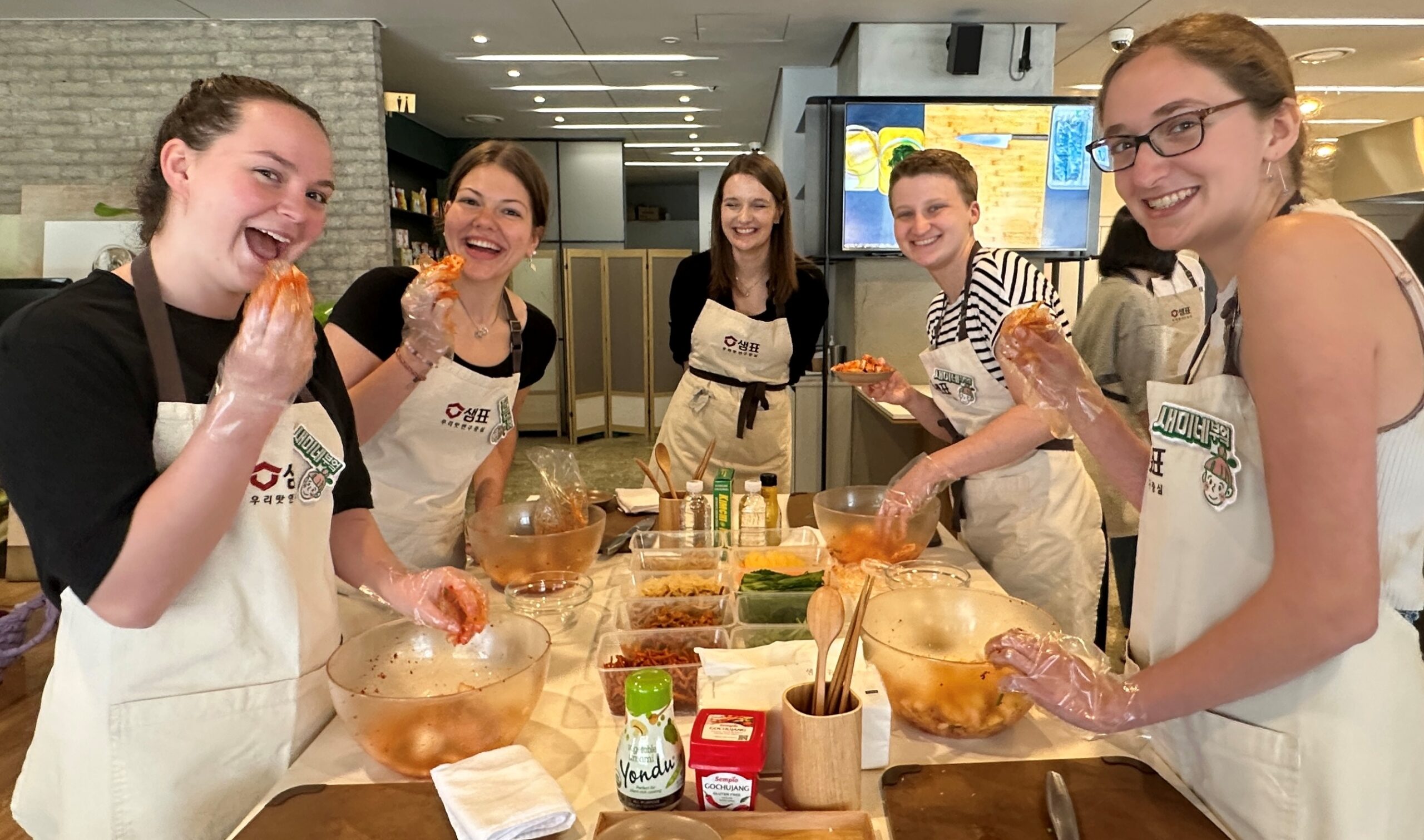With the global rise of the Korean Wave, K-Food is gaining worldwide attention. Many foreign tourists visiting Korea are not only interested in tasting Korean cuisine at restaurants but also in learning how to cook it themselves. In such cases, one of the best experiences is a K-Food Cooking Class. Among various Korean dishes, Bulgogi and Bibimbap are iconic staples that symbolize Korean food culture. They are relatively simple to prepare, rich in flavor and nutrition, and thus frequently featured in cooking class programs.
Bulgogi: The Essence of Korean Marinated Beef
Bulgogi is a traditional Korean dish made by marinating thinly sliced beef in a mixture of soy sauce, garlic, sugar, and sesame oil, then grilling it over fire. While the exact proportions of seasonings may vary across regions and households, the signature “sweet and savory” soy-based flavor remains consistently appealing. Bulgogi has long been a favorite dish served both as an everyday side and for special guests, and it continues to be one of the most beloved Korean foods among foreigners.
In a cooking class, you’ll first learn how to prepare the meat — from trimming fat and membranes to slicing it thin enough to absorb the marinade properly. Then, you’ll create the marinade by mixing soy sauce, sugar, garlic, ginger, sesame oil, and chopped scallions in the right ratio. While the instructor may offer a “golden recipe,” Korean cooking embraces flexibility, allowing you to adjust flavors to your personal taste.
Many classes also feature a “Bulgogi Jeongol,” a hot pot version of bulgogi stir-fried with vegetables and a light broth for a heartier meal. The finished dish can be enjoyed over steamed rice as a bowl dish or wrapped in lettuce for a refreshing K-style ssam (wrap). Bulgogi’s versatility makes it ideal for both beginners and experienced cooks eager to explore Korean cuisine.
Bibimbap: A Bowl of Colors and Nutrition
Bibimbap, which literally means “mixed rice,” is a quintessential Korean dish where an assortment of seasoned vegetables is arranged on top of rice and mixed with gochujang (Korean chili paste) sauce before eating. It’s often recognized as one of Korea’s most representative dishes and has even been served to foreign dignitaries during UNESCO-designated royal ancestral rituals, highlighting its cultural significance. With its beautiful colors, balanced nutrition, and rich flavors, Bibimbap enjoys great popularity as a healthy modern meal.
In a cooking class, the first step in making bibimbap is blanching and seasoning various vegetables such as spinach, bellflower roots, bracken, bean sprouts, and zucchini. Each vegetable requires a slightly different cooking time to preserve its crisp texture. The key component — the gochujang sauce — is made by blending gochujang with corn syrup or sugar, vinegar, and other condiments to achieve a sweet yet umami-rich taste.
Once you place shining white rice in a bowl, add neatly arranged vegetables by color, and top it with a fried egg or marinated beef, your bibimbap becomes complete. A sprinkle of sesame seeds finishes it off beautifully. The joy of mixing and eating your own bibimbap brings smiles all around — especially if you’re taking the class with friends or family members, making it a fun, bonding experience filled with laughter and creativity.
Cooking Class Atmosphere
Major tourist cities like Seoul, Busan, and Jeju offer a variety of cooking classes in different formats. Some classes take place in large studios with more than ten participants, while others are held in small workshops or homes with just two to four people. Most sessions last about two to three hours, and many offer English translations or are conducted entirely in English — making them accessible even for visitors who don’t speak Korean.
Once the class begins, participants gather around a kitchen table set with neatly prepared ingredients and utensils. The instructor introduces the cultural and historical background of the dish, followed by hygiene steps like washing hands and wearing aprons. As you cook step by step, you can freely take photos and videos, perfect for sharing later on social media. During the tasting session at the end, participants often exchange thoughts on how they might tweak the seasonings, creating an open and enjoyable opportunity to experience Korean food culture firsthand.

Sub Ingredients and Alternatives
While cooking class recipes are based on traditional versions, it can sometimes be challenging to find certain ingredients when cooking at home abroad. For example, condiments like ssamjang, Korean soy sauce, or perilla oil may be hard to find at local supermarkets. Fortunately, instructors often recommend suitable substitutions. Many classes also cater to dietary preferences such as halal or vegetarian, suggesting how to omit meat or adapt seasonings accordingly. This recipe flexibility is part of what makes Korean cuisine both attractive and accessible to everyone.
After the Course: Enjoying K-Food at Home
At the end of most classes, participants receive a recipe card or booklet, allowing them to recreate the dishes confidently at home. This is one of the biggest advantages of joining a Korean cooking class — you can revisit what you learned, experiment with flavors, and even share your creations on social media or blogs. Each session deepens your personal connection with K-Food.
If you need specific ingredients unavailable locally, instructors often suggest ordering from online Korean grocery stores or visiting Asian markets. Some participants have even shared testimonials like, “I hosted a home party with my own bulgogi sauce, and everyone loved it so much that I’m planning another trip to Korea.” In this way, cooking classes go beyond simple cooking lessons — they become immersive cultural exchanges and meaningful travel experiences.
Various Cooking Class Programs
Beyond bulgogi and bibimbap, there are classes for making kimchi, rice cakes (tteok), japchae, seafood pancakes (haemul pajeon), hot pots, and other more advanced Korean dishes. Participants can select classes based on their travel schedule or personal interests, and even combine multiple sessions for a full-day experience. Some tourists choose programs that pair cooking with cultural activities such as wearing hanbok or learning Korean etiquette for a complete “K-Culture immersion” day.
Conclusion: The Joy of Korean Cuisine at Your Fingertips
A K-Food cooking class goes far beyond eating — it’s a full sensory experience where participants actively engage with Korea’s culinary culture. While dishes like bulgogi and bibimbap may be familiar to locals, they become exciting and novel challenges for visitors and food enthusiasts. As you mix vibrant vegetables and bold seasonings with your own hands, you realize that K-Food transforms from “a delicious dish to admire” into “a delightful part of your everyday life.”
While travel memories often fade into photos or souvenirs, the skills and recipes learned from a cooking class offer lasting value. You can recreate the dishes at home, stay connected with people you met during the experience, and continue sharing Korean food culture wherever you go. Much like the colorful harmony of ingredients in a bowl of bibimbap, your time in a cooking class will enrich your trip with unforgettable, flavorful memories.


WeBring Service : Provides personalized services to foreigners living in Korea
Exclusive offer: Introducing foreign car rental in Korea, WeBring-SoCar

